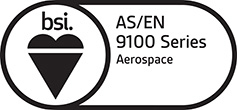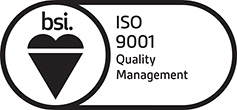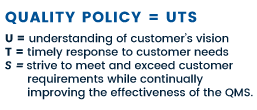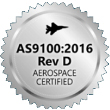We evaluate your suppliers Quality Assurance System
Quality Assurance auditing is one of the core services we offer clients in aviation, aerospace, defense and other industries. Organizations in these sectors face a clear need to meet exceptional quality benchmarks while keeping costs down and remaining competitive. Third party Quality auditing is a systematic examination of a quality system, product or process. Our experienced Technical Specialists follow a regimented audit plan to provide the information you need to determine where gaps currently exist and observations for improvement can be made.
A well-developed Quality Management System means a company has defined roles, responsibilities, documentation, and action plans for managing performance and continuously improving operations in each these areas; Operations, Accounting, Human Resources, Engineering, Sales, Procurement and Contracts.
A periodic review of a QMS is important to validate the defined processes and procedures are being followed and relevant to the operation of the organization. The second aspect of the QMS audit is to validate that the Quality Management System is compliant to the standard from which it was written.
A quality system audit is defined as a “systematic and independent examination used to determine whether quality activities and related results comply with planned arrangements and whether these arrangements are implemented effectively and are suitable to achieve objectives”. Further, it is a “documented activity performed to verify, by examination and evaluation of objective evidence, that applicable elements of the quality system are suitable and have been developed, documented and effectively implemented in accordance with specified requirements.”
The aim of a regulatory audit is to verify that an operation is compliant with regulations and standards and provides statutory reporting for regulated entities. The regulatory audit must be accurate, objective, and independent while providing oversight and assurance to the organization.
The audit reviews provide a systematic approach to data collection which includes assessing risks by reviewing corporate controls over trade compliance.
For example, an FAA regulatory audit is used to evaluate the actual operating practices of production approval holder and delegated facilities against the Code of Federal Regulations, FAA-approved data, and the facility’s internal procedures. Any inconsistency discovered is categorized and recorded. This data is provided to the production approval holder or delegated facility at the conclusion of the evaluation and analyzed annually for trends.
Process audits revolve around verification of the manner in which: People; Material; Machines, Methods, Measurement and Environment come together to produce a product. A process audit compares and contrasts the manner in which the end product is produced to the written procedures, work instructions and workman-ship standards, are used to guide the manufacturing process responsible for building the product. Process audits are assessment based and analytical in nature. The process audit is also concerned with the validity and overall reliability of the process itself.
Product audits are an examination of a particular product or service performed periodically throughout a production run to ensure continued compliance to the print, specifications, performance standards, and customer requirements. The control plan or part specific inspection instructions usually are used to dictate how many pieces to check and at what frequency to meet statistical requirements. This is not 100% dimensional inspection; only a few critical dimensions are monitored.
A special process is broadly defined as any production or service process which generates products or services which cannot be measured, monitored, or verified prior to delivery and use. Guidance within ISO 9001 outlines that “The organization shall validate any processes for production and service provision where the resulting output cannot be verified by subsequent monitoring or measurement. This includes any processes where deficiencies become apparent only after the product is in use or the service has been delivered”.
In these special process audits you need to see the controls that the supplier has implemented. Copies of process specifications, work instructions, test instructions, process test results, training requirements and training records, are among the documentation that should be supplied and reviewed to ensure the process is managed appropriately.
For aerospace manufacturers, special process accreditation is issued by NADCAP (National Aerospace and Defense Contractors Accreditation Program). NADCAP audits are process-specific and very detailed. NADCAP accreditation is solely administered by the Performance Review Institute (PRI).
Unitek can assist with the assessment of the supplier’s special process operations in preparation for the NADCAP certification or perform a review of compliance to the NADCAP standard.
Pre-Production Validation is an assessment to confirm the supplier can consistently manufacture the product at the necessary production rate. The purpose of the pre-production assessment is to provide a first look to uncover high impact production weaknesses early in the product lifecycle.
A Supplier Survey is used by a company to collect information from current and/or prospective suppliers to gage whether or not they satisfy specific production capability of the customer.
A company can strengthen its own mission by making sure it engages with suppliers that have aligning production capabilities and business means. Conducting a Supplier Survey is way for companies to assess their current suppliers to see if their business practices matchup with their business standards. A company may also use this to evaluate prospective suppliers and decide whether or not they are a good fit. If a company’s suppliers have goals that are in line with its own, these suppliers become not only a resource, but also a partner in furthering the company’s vision.
Supplier evaluation is a continual process within the purchasing and quality departments. It forms part of the pre-qualification step within the purchasing process, although in many organizations it includes the participation and input of other departments and stakeholders. Most firms performing supplier evaluations do so using a multistep processes. Their processes often take the form of either a questionnaire or interview, sometimes even a site visit. This involves appraisals of various aspects of the supplier’s business including capacity, financials, quality assurance, organizational structure and processes and performance. Based on the information obtained via the evaluation, a supplier is scored and either approved or not approved as one from whom to procure materials or services. In many organizations, there is an approved supplier list (ASL) to which a qualified supplier is then added.
There are various benefits associated with an effective supplier evaluation process such as mitigation against poor supplier performance or performance failures. The benefits typically include sourcing from suppliers that provide high standards of product and service levels while offering sufficient capacity and business stability. Supplier evaluation can help customers and suppliers identify and remove hidden cost drivers in the supply chain. The process of evaluating performance can motivate suppliers to improve their performance.
Digital Product Definition (DPD) – The electronic data elements that specify the 3D Computer Aided Design (CAD) geometry and all design requirements for a product (including notation and parts list) and the use of this data throughout and integrated CAD/Computer Aided Manufacturing (CAM) and Coordinate Measurement Systems (CMS).
Model Based Definition (MBD) – A dataset containing the exact solid, it’s associated 3D geometry and 3D annotation of the product’s dimensions and tolerances (and may include parts/notes list) to specify a complete product definition. MBD is one possible format of DPD.
The purpose of a Digital Product Definition (DPD) / Model Based Definition (MBD) Audit is to facilitate supplier deployment of DPD/MBD processes and to achieve technical coordination between customer, supplier and sub-tier suppliers.
The scope is to ensure that the supplier and sub-tiers have a process of continuity through a DPD/MBD Manual that outlines all the requirements to perform this activity. Checklists are developed to verify compliance of the DPD/MBD processes to manufacture and inspect product.
- DPD/MBD Quality Assurance Procedures and Documented Processes
- Documented Processes
- Flow Diagram
- Responsibilities
- Configuration Management and Media Security
- Media Security
- Configuration Management and Traceability
- Engineering Type Design
- Product Acceptance Software (PAS) Validation
- Commercial Off The Shelf Software
- Computer Aided Manufacturing Software
- Supplier Developed Software
- Internal Quality Audits
- Internal Audits
- Procurement Control
- Sub-tier Supplier Activity
- Export Control
- Right of Entry
- Control of Measurement Equipment
- Calibration
- Coordinate Measurement Systems (CMS) Procedures
- Inspection Media
- Inspection Planning for Validation
- Inspection Media
- Reduced Content Drawings
- Printed Wire Boards (PWB)
- Model Based Definition
- First Article Inspection
- Customer Provided Plots
- Customer Product Definition Template (PDT)
- Supplier Created Plotted Media
- Validation of Plot Accuracy
- Environmental Controls
- Handling Storage
- Destruction of Obsolete/Unusable
- Deviations
- Data Exchange Methods
- CAD Compatibility Requirements
- Translations
- Special Tooling
- Tool Design
- Traceability
- Inspection
- Training and Process Performer
- DPD Training
Learn more about how our audit programs work today!




